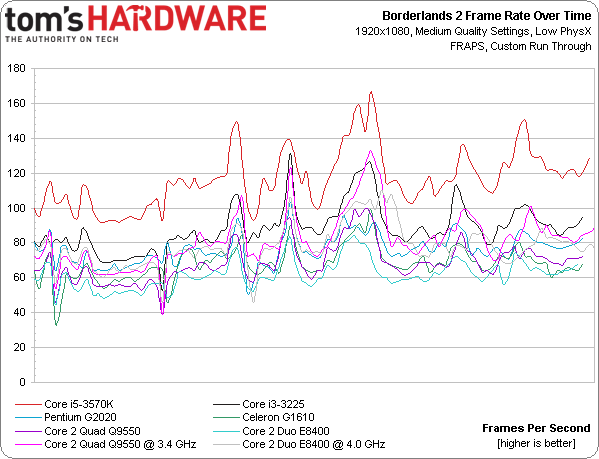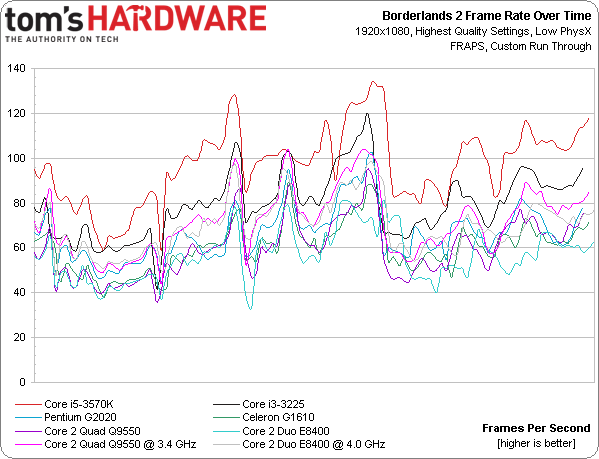Is This Even Fair? Budget Ivy Bridge Takes On Core 2 Duo And Quad
Reader requests affect much of the work we do, and we constantly receive email asking for this one: compare Intel's older Wolfdale- and Yorkfield-based designs against today's budget-friendly Ivy Bridge-based processors. Well, you asked, and we deliver.
Results: Borderlands 2
We start with our Tom’s Hardware Borderlands 2 manual run, which takes approximately 105 seconds to complete.
I've never been a fan of charting absolute minimum frame rate figures alone, since those floors may not be apparent during game play. Rather, I'm more concerned with sustained minimums and perceived smoothness (though these don't necessarily guarantee a smooth and enjoyable experience, as we’ve seen from dual-GPU configurations). I see minimums as most useful if they don't drop below a defined level, as opposed to a single dip at one point in time.
Charting frame rates over time in a line chart helps quite a bit in this area. But it also exposes an anomaly in how Fraps measures minimum FPS. For the Celeron G1610, our log shows the lowest second measured 34 FPS, while all other seconds were well above 40 FPS. But because Fraps reports a minimum of 29 FPS, we have to assume that absolute minimums are either calculated based on frame times or measured at far more frequent intervals than once per second.
This isn’t a fluke, it isn’t limited to one processor or platform, and it isn't exclusive to just this story. In fact, if the reported minimums and frame rate over time charts appear to match, then it's probable that the minimum was adjusted to match the frame rate over time log. Usually, we see a difference of one to four frames per second. But occasionally, the delta is even higher. We aren't going to make that adjustment in today's numbers, but keep this in mind as you read through today's analysis, and any other Fraps-based performance reporting moving forward. Bottom line: don't get too hung-up on the minimum FPS bar without first looking over the matching line graphs. Charting both lets you decide which number is more important.
Each processor delivers a nice playable experience at Medium settings. However, a couple of those downward spikes near the beginning of the run corresponded to a brief, yet still noticeable stutter.
The Radeon HD 7970 has no problem handling the highest quality settings in this DirectX 9 title, and CPU scaling remains abundantly clear. Core i5-3570K extracts the most potential from our graphics hardware, but every single one of these processors is at least capable of delivering an acceptable Borderlands 2 experience.
In a game supposedly optimized for four cores, it is interesting that the stock-clocked Core 2 Quad Q9550 only delivers about the same performance as a Celeron G1610. Also note that the Core i3-3225 is punished with a reported minimum of 32 FPS, though its frame rate over time log never drops below 42 FPS. In fact, the single lowest second logged overall for any of these processors was 37 FPS, yet half of them have reported minimums below 34.
Get Tom's Hardware's best news and in-depth reviews, straight to your inbox.
-
ASHISH65 Wow! this is the review i am waiting from long time.Really good one for budget gamers.Reply -
DarkSable Now this is cool stuff.Reply
Also, amoralman, did you read this? It's basically assuring you that your C2D is still awesome as a budget processor. -
Steelwing Very nice review! I've got a C2D E6600 (2.4 GHz) and had been considering the Core i5-3570K (or possibly wait for a Haswell i5) and was wondering about the performance differences. My CPU is still good for a lot of apps, but I can definitely see a reason to upgrade.Reply -
AMD Radeon pentium dual core G2020 is the minimum i can recommend to budget gamers. i often listed it in sub 450 gaming PCReply -
lpedraja2002 Excellent article, I'm glad I have a more accurate idea on where I stand based on CPU performance, I'm still using my trusty Q6600, G0 @ 3.2ghz. Its good that Tom's still hasn't forgotten that a lot of enthusiast still are rocking Core 2 architecture lol. I think I can manage until Intel releases their next revolutionary CPU.Reply -
assasin32 I been wanting to see one of these for a long time but never thought I get to see it. I just wish they had the good ol e2160, and q6600 thrown into the mix. I have the e2180 OC to 3ghz. It's still chugging along surprisingly enough, I just realized how old the thing was last night after thinking about how long I've had this build and looking up when the main components were produced. Safe to say I got my use out of that $70 cpu, did a 50% OC to it :) and it still had room to go but I wanted to keep the voltage very low.Reply -
jrharbort I've always been curious about how well my own Core 2 Duo P8800 (45nm & 2.66GHz) would stand up against modern ivy bridge offerings. And even though I'm talking about he mobile space, I'm guessing the gains would be comparable to those seen by their desktop counterparts. Each day I'm reminded more and more that I seriously need to move on to a newer system, especially since I work with a lot of media production software. Thanks for the article, it provided some interesting and useful insight.Reply -
smeezekitty Kind of interesting that the old Core 2s beat the I5 in tombrader with TressFX on.Reply
Also holy crap on 1.45 vcore on the C2D -
Proximon I would not have predicted this. Not to this extent. I hope we can make these broader comparisons across years more frequently after this. I predict this will be a very popular article.Reply



